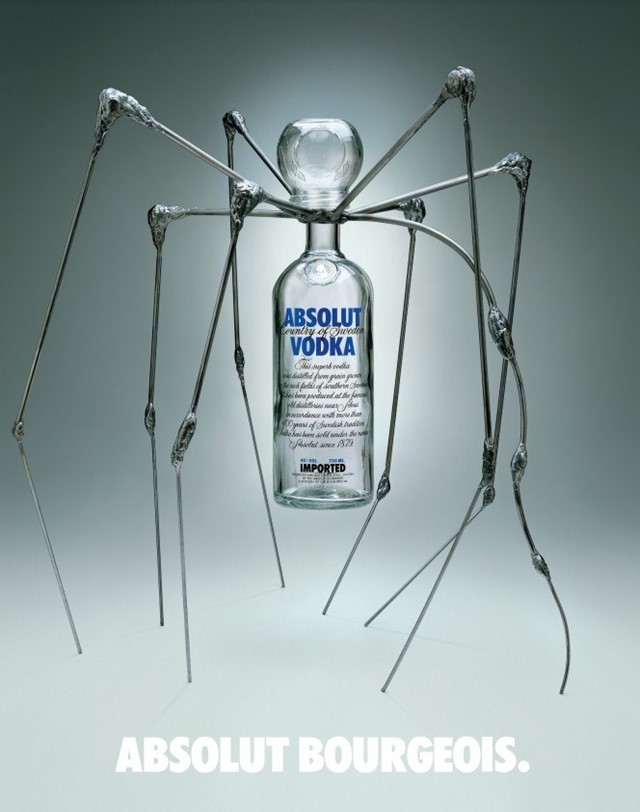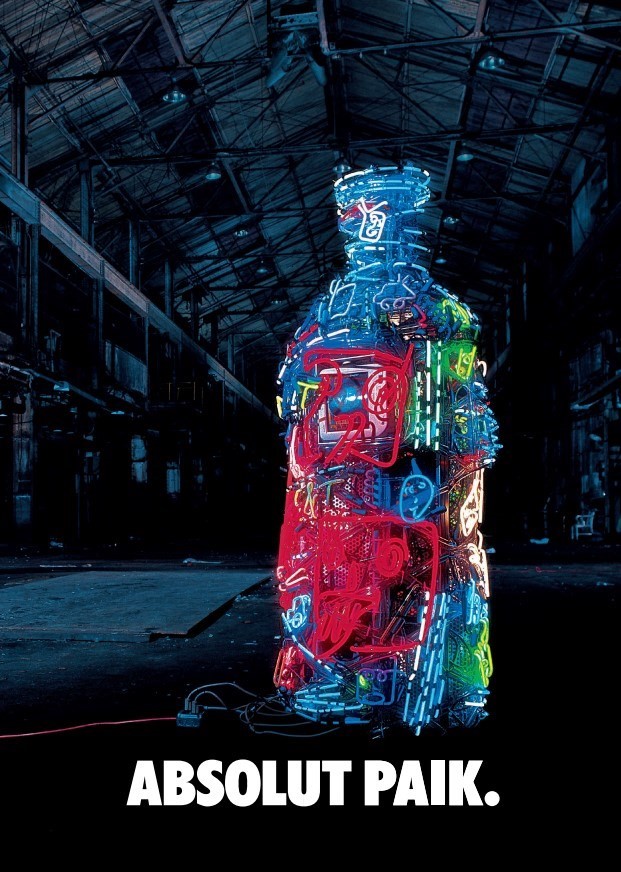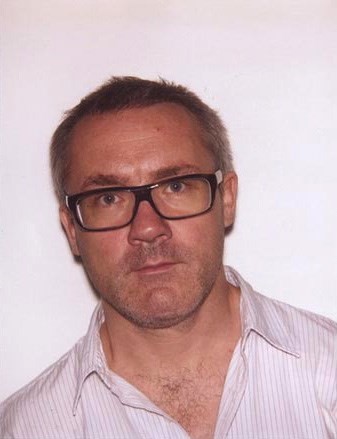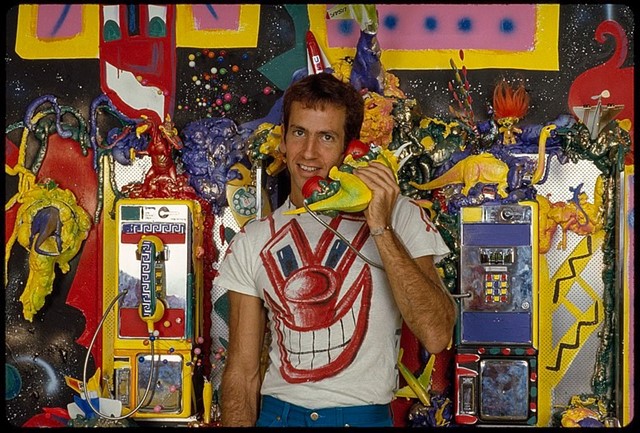Andy Warhol, Louise Bourgeois, Nam June Paik, and many more have reimagined the vodka brand’s iconic bottle – a legacy captured in a new film by Seth De Silva
AbsolutAbsolut’s collaborations with icons of visual art date back to the 1980s, when – so the story goes – Andy Warhol spotted one of the Swedish vodka brand’s bottles across the bar at Studio 54, after it was introduced to the US by the famed liquor executive Michel Roux. Latching on to the apothecary-inspired shape of the glass, the same way he took a shine to soup cans two decades before, the artist met with Roux and told him: “I love the bottle. I’d like to do something.”
This meeting would kickstart a long-running series of ads with some of the biggest names in the art world. According to Absolut archivist Lovisa Severin Kragerud, Roux asked Warhol to recommend “up-and-coming artist friends” after commissioning two paintings from the artist himself, and ended up bringing a range of other pop artists into the mix, including Keith Haring, Kenny Scharf, and Romero Britto. From there, she adds: “The community just grew.”
In 1988, for example, Ed Ruscha would pair the clear vodka bottle with the silhouette of a howling wolf. Later, it would be integrated into Louise Bourgeois’ seminal spider sculpture, Maman. Throughout the 90s and 2000s the community expanded even further, with campaigns designed by Maurizio Cattelan and Rosemarie Trockel, alongside Young British Artists such as Angus Fairhurst, Damien Hirst, and Chris Ofili. Back in the US, ads by the likes of Oscar Marine and Kurt Vonnegut occupied magazine pages and major billboards.
Notably, each campaign focuses heavily on the style of the featured artist, embracing everything from the minimalism of Thea Djordjadze, to the luxury aesthetics of Sylvie Fleury (who wrapped the bottle in opulent chrome). That’s not to mention Absolut’s crossovers with music, fashion, and film, which have handed the reigns to Lenny Kravitz, Tom Ford, Spike Jonze, and many more, for interpretations that transcend visual art.
Alongside Absolut’s in-house print adverts, these collaborations represent its commitment to building a creative community, mixing a range of artistic outlooks, and championing broader social concerns (one of the very first ads the brand ran in a magazine was in the LGBTQ+ publication The Advocate). Obviously, this paid off. Today, Absolut is one of the largest spirits brands in the world, and its vodka’s wild success beyond the Swedish border is largely credited to the artists who helped sell it to the masses. Even now, a wave of enthusiasts will go to great lengths to get their hands on the artist-led designs. In fact, US libraries had “a big problem” on their hands as Absolut ads began to blow up in the 80s, Kragerud says, as “people went there for the magazines and tore the ads out” to add to their collections.
Nowadays, many of the older Absolut collaborations aren’t so easy to track down – never mind taking them home to stick up on your bedroom wall. However, over 850 of the artworks, by more than 550 individual artists, are on display in the Absolut Art Collection at Stockholm’s Spritmuseum, while the new short film above – animated by the London-based artist Seth De Silva – traces their lineage across the last 40 years.
Watch this space for more from Absolut and Dazed. In the meantime, you can revisit some of the vodka brand’s best artist collaborations in the gallery below.
 © The Absolut Company 2003 / Louise Bourgeois (Photo: Christopher Burke)
© The Absolut Company 2003 / Louise Bourgeois (Photo: Christopher Burke)LOUISE BOURGEOIS
You probably (hopefully) don’t associate a good night out with giant spiders – even less with your mother. In 2003, however, Louise Bourgeois felt differently. In what is now considered one of the most iconic Absolut adverts to date, the vodka bottle replaces the egg sac in a recreation of Maman, Bourgeois’ large-scale steel spider sculpture that typically trades the alcohol for 17 marble eggs. This contribution to the Absolut Generations project was exhibited at the Venice Biennale in 2003, when the artist would have been 91 years old and had already received a lifetime achievement award at the 48th biennale, signalling the continued strength of Absolut’s collaborations, twenty years after they began.
 © The Absolut Company 1999 / Nam June Paik
© The Absolut Company 1999 / Nam June PaikNAM JUNE PAIK
Nam June Paik was the first artist enlisted to create an Absolut campaign in the year 2000, meaning that the then-68-year-old was tasked with marking the start of a new millennium. And who better for the task than the “godfather of video art”, whose insights are still ringing true to this day? Reflecting his past gallery installations, the ad features an electronic sculpture that stands seven feet high, in the shape of… you guessed it, an Absolut vodka bottle. Nestled inside the sculpture are video screens, interwoven with coloured neon tubing that lights up the darkened warehouse where the sculpture is photographed. Despite Paik’s forward-facing approach to art in a changing world, his installation also recalls the energetic lines of Keith Haring’s interpretation, or the smiley faces and odd symbols that cropped up in work by Kenny Scharf – perhaps the artist’s own playful nod to the impressive lineup of Absolut collaborators that came before him.
 Via Wikimedia Commons
Via Wikimedia CommonsDAMIEN HIRST
In the year 1999, on the eve of the new millennium, Absolut commissioned 17 European contemporary artists to “capture the spirit of the age” for a series of adverts in Time magazine, including Chris Ofili, Francesco Clemente, and Jan Saudek. First, though, came Hirst. Arriving at the end of a decade that had seen him achieve worldwide fame (and notoriety) with sharks and cut-up cows preserved in formaldehyde, the ad made a playful reference to his work. An Absolut bottle is suspended in a sterile display case, with another bottle suspended inside the first, and another inside that, like nesting dolls. Thankfully, he did manage to keep the rotting flesh to a minimum.
 © The Absolut Company 1998 / Maurizio Cattelan
© The Absolut Company 1998 / Maurizio CattelanMAURIZIO CATTELAN
Maurizio Cattelan followed Damien Hirst in the series of millennial artworks published in Time, long before he became famous for crafting a golden toilet, or for his $120,000 banana taped to a wall at Art Basel. For his contribution, the Italian artist dropped a mouse into the empty bottle, where it sits clutching its head, hinting at a hangover. Obviously, Maurizio Cattelan has never taken himself too seriously, and has always had a keen eye for a joke, while Absolut has offered pretty much free reign to the artists it hires.
 Via Wikimedia Commons
Via Wikimedia CommonsKENNY SCHARF
Andy Warhol and Keith Haring plastered the Absolut bottle in the primary colours of pop art, but Kenny Scharf (then a relative unknown, who supposedly got the job on Warhol’s recommendation) took it intergalactic. Echoing Scharf’s signature sci-fi settings and cartoonish style, the painting transforms the vodka bottle into a green, lowbrow alien, surrounded by whooshing rockets, swirling galaxies, and bright yellow gelatinous shapes. A second artwork is set in the desert, with spirits escaping the neck of the bottle like aliens lifting off from Area 51 – far from the sleek and sophisticated (read: boring) ads that were synonymous with the alcohol industry up to that point. Looking back on Scharf, Roux said he was “one of the most difficult artists” he’d ever have to deal with, but admits that his art campaign solidified the “tremendous success” of the ongoing collaborative project.